In HPHT or deepwater operations, differences in shale and sand fracture gradients can result in kicks with simultaneous gains and losses. Options for handling these scenarios are available, but must be applied in a logical sequence.
Fred Ng, Wild Well Control
In most High-Pressure, High-Temperature (HPHT) wells, margins between fracture gradient, mud weight and pore pressure are typically close, leading to loss of returns as one of the most common complications in kick handling. Operational and technical options for handling some typical scenarios—including simultaneous occurrence of losses and influx—are not unfamiliar to the industry, but application of these measures in a logical sequence can help produce successful outcomes. Case studies from HPHT wells illustrate relevant issues, including applicable mitigations and contingencies for well planning and drilling operations.
FRACTURE GRADIENTS IN SHALE AND SAND
It has been recognized for some time that, for a given depositional environment, Fracture Gradient (FG) in shale can be appreciably higher than in sand. Such differences in FG have long been applied to design of fracture stimulations, including containment of such fracs within the sand body being simulated. In recent years, there has been increasing recognition of this difference in terms of well control, particularly in deep, HPHT or deepwater drilling projects, where kick margins can often be small and therefore critical.
An example from a typical deepwater project is seen in Fig. 1, which shows a difference of 0.5–1.0 pounds per gallon (ppg) between the shale and sand fracture gradients in the deep sections below the base of salt at a depth of about 25,000 ft. It is not unusual in this type of wells to find the hole unable to hold a kick even though shut-in pressure is below the pressure to which the casing shoe was tested. Since most casing shoes are set in shale formation, this condition is likely caused by FG difference between the shale at the shoe and a sand formation in the open hole, including the source sand of the kick in some cases.
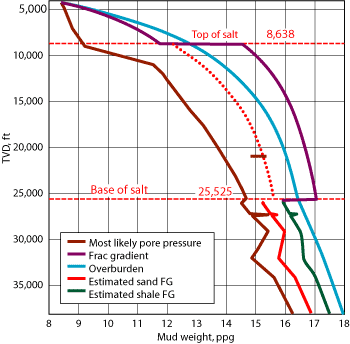 |
|
Fig. 1. A difference of 0.5–1.0 ppg can be seen between the estimated shale and sand fracture gradients below 25,000 ft.
|
|
When a kick is shut in, wellbore pressure charges up in a mechanism similar to that of a leak-off test, such as shown in Fig. 2. As long as pressures have not reached Formation BreakDown (FBD) pressure—at which point induced fractures will open and propagate—the formation will recover and be able to contain pressures below FBD. However, once FBD is exceeded, the formation can only hold its Fracture-Closing Pressure (FCP), which is lower than FBD.
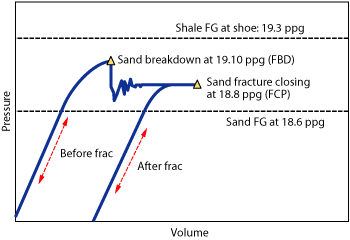 |
|
Fig. 2. Effect of the differential between sand and shale FGs.
|
|
For the kick shown in Fig. 2, shut-in pressure is lower than FG of the shale at the shoe, but is higher than that of the source sand in the openhole section. In terms of kick containment, the above mechanism means as long as Equivalent Mud Weight (EMW) remains below 19.1 ppg, which is the sand’s FBD, the hole can contain the pressures needed to shut in and circulate the kick. There may be limited mud loss, and the sand may get charged up to the kill mud weight used, but there should be no massive losses. If FBD is exceeded by a higher shut-in pressure or by bullheading, then the hole will only be able to contain an EMW equal to the sand FCP of 18.8 ppg. Under these conditions, induced fractures in the sand will open and close at about the same pressure, resulting in a scenario where the hole loses mud and flows at practically the same mud weight. In fact, bullheading is likely to charge up the sand with a reservoir pressure equal to FCP, and the well can continue to lose and gain at the same mud weight until most or all of the bullheaded volume is flowed back, and the induced fractures can close up and heal.
KICKS WITH LOSSES
Following are two case histories of such simultaneous occurrence in an HPHT environment. Although depths and other details have been modified with FG values that are consistent with those shown in Fig. 2, the basic principles involved remain unchanged. Since oil-based mud was used, downhole values of densities and gradients are important, as well as Surface Mud Weight (SMW). Wherever appropriate, downhole values of the leak-off test and Equivalent Static Densities (ESDs) are referenced in these descriptions. All FGs cited are based on downhole values.
The schematic in Fig. 3 shows that Operator A’s well took a kick at 18,200 ft. Shut-in pressure and Kill Mud Weight (KMW) were below the shale FG of 19.3 ppg at the shoe, but exceeded the sand FG of 18.6 ppg. However, since pressures did not exceed the sand FBD of 19.1 ppg, the kick was circulated out with limited mud losses at 18.4 ppg SMW/18.6 ppg ESD. One result is that the sand was charged to a reservoir pressure equal to the KMW of 18.6 ppg. Subsequent drilling experienced losses with the pump on at an Equivalent Circulating Density (ECD) of over 19.1 ppg, and experienced flow with the pump off at 18.4 ppg SMW/18.6 ppg ESD. Since the well was still able to hold 18.8 ppg, well control was maintained by keeping this EMW in the hole, which was monitored with a pressure-while-drilling tool in the drillstring. Pump rate was limited to control ECD while circulating, connections where made while trapping over 200 psi using the annular preventer, and trips were made while spotting heavy pill on bottom. The well was drilled to a TD of over 20,000 ft, with the gas reading on the mud logs showing formation pressure below the ESD of 18.6 ppg. The well was successfully logged after spotting a heavy mud pill and POOH.
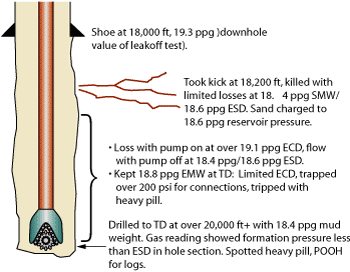 |
|
Fig. 3. Simultaneous kick and loss experienced by Operator A.
|
|
Figure 4 shows that Operator B took the same kick at 18,200 ft, under the same conditions. Instead of circulating out the kick, the well was bullheaded with some 2,000 bbl of 18.4-ppg mud. As a result, the sand was fractured and charged to its FCP (equivalent to 18.8 ppg), thus creating a fractured reservoir that would lose and gain at about the same mud weight. Drilling proceeded with continuous losses at ECD of over 18.8 ppg. Since the well would flow with the pump off at 18.4 ppg SMW/18.6 ppg ESD, connections were made while continuously pumping and with mud loss into the annulus, and no bit trips could be made. By the time an 18,800-ft TD was reached, the well had experienced a total mud loss of over 5,000 bbl, and there were no easy alternatives to POOH for logs without bleeding and circulating out most of this mud volume. Simulations indicated that, based on shale FG limit at the shoe, such a bleed-and-circulate operation would be limited to 120 bbl per cycle at a pump rate of 1 bbl/min. Estimated rig time required to complete this bleeding would be up to 45 days.
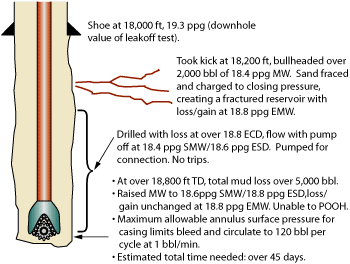 |
|
Fig. 4. Simultaneous kick and loss experienced by Operator B.
|
|
OPTIONS FOR HANDLING KICKS WITH LOSSES
Discussed below are some options for handling typical scenarios involving simultaneous occurrence of losses and influx.
Scenario 1: Hole holds at shut-in, attempt made to circulate kick. If there was prior experience of loss in the hole section, consider adding lost circulation material to the kill mud. Establish the driller’s method (a well-killing method involving two circulations, one to circulate the formation fluids out of the well and the other to circulate heavier mud through the wellbore) at the slowest practical pump rate. If losses develop, then shut down and restart the mud pumps at a reduced rate.
It may sometimes be necessary to use the “Barrel-In Barrel-Out” (BIBO) method, which involves adjusting the choke setting to establish a slow pump rate that results in no mud loss or gain. Once the rate is thus established, note the pump pressure at this point and keep it constant. Maintain this rate until the influx is above the casing or liner shoe, at which time a similar process can be used to step up the pump rate.
Scenario 2: Unable to establish stable kill rate. In cases that involve simultaneous loss and gain, it is difficult to establish control, since effects of the two can mask each other. The pit level in these situations can only indicate net change, but not the effects of each individual occurrence. Attempting to circulate under these conditions can result in large undetected losses and/or influx.
It is important to resolve the two occurrences one at a time. The priority in this scenario should be to cure losses with pills and squeezes as needed. Wireline logs such as temperature, noise, neutron (for gas/liquid differentiation) and stuck pipe logs may be needed to diagnose flows and locate sources and exit points in the annulus.
If the losses cannot be cured, an alternative is to stop the influx by spotting one or more barite plugs. Pumping cement is usually not advisable in the presence of gas, since it tends to form a porous “honeycomb” that does not provide an effective seal. In some cases, it can set up enough to block needed pumping access, but at the same time it fails to plug off the influx. One drawback with barite plugs is that they are difficult to drill up, often resulting in unintended sidetracks when the well is subsequently re-entered. It is usually advisable to use specialists for these unconventional well control operations.
Scenario 3: Hole does not hold when kick is shut in. In this case, an underground cross-flow may already be occurring. Diagnostic and treatment options are similar to those in Scenario 2.
Sandwich kill is sometimes used, but this method often has limited success. Another option, dynamic kill, can also have limited success, depending on whether there is a long enough hole interval between source and exit, the volume of kill fluid, the pump rate and horsepower required, and availability of high-performance pumping equipment.
SIMULATION
Simulation of kick circulation can be helpful for managing well control risks in these situations. It can show pressure, volume and other parameters and trends for a successful kick circulation, which provides guidance for diagnosis when actual parameters deviate substantially from the simulated results.
Most drilling professionals developed their well control knowledge and experience in a Water-Based Mud (WBM) environment involving conventional depths of 15,000 ft or less. Well control schools also often base their tests and simulations on the same type of wells. Since kick handling is not a frequent occurrence for most operations, parameter trends from such conventional kicks tend to form the basis for making well control decisions.
The above limitation can result in problems when diagnosing and making decisions with kicks involving deep, HPHT or deepwater operations, particularly if oil- or Synthetic-Based Mud (SBM) is used. Pressure, volume and other parameter and trends for a successful kick circulation in these wells can be very different than what might be intuitively inferred from experience with conventional WBM operations. Most of the effects are due to differences in compressibility of diesel- or synthetic-based oil compared with water, as well as differences in gas solubility in these fluids. For example, Fig. 5 shows a simulation of circulating out a 120-bbl swabbed kick from 12,500 ft with WBM. Figure 6 show a simulation for a 100-bbl kick circulation from 20,700 ft in SBM. Even though both used driller’s method circulation, comparison of the Choke Pressure (CP) profiles for the two cases show very different trends. The WBM case shows CP at a maximum when gas reaches the surface, while the trend is exactly reversed in the SBM case, with maximum CP occurring at initial shut-in.
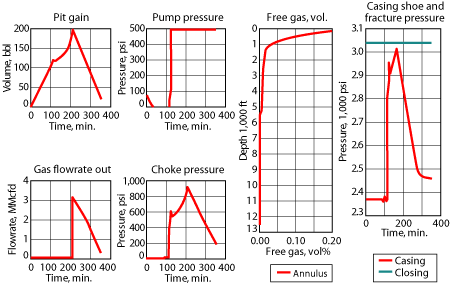 |
|
Fig. 5. Simulation of circulating out a 120-bbl swabbed kick from 12,500 ft with WBM.
|
|
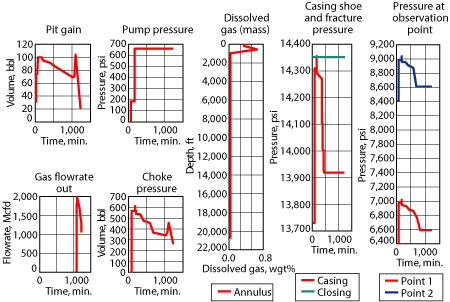 |
|
Fig. 6. Simulation of circulating out a 100-bbl kick from 20,700 ft with SBM.
|
|
In a recent case, an operator took an 80-bbl kick at 27,000 ft while drilling in 7,000-ft water depth with 15.0-ppg SBM. Initial Shut-In Casing Pressure (SICP) was 1,800 psi. Based on the operator’s experience with conventional WBM operations, there was concern that CP might increase to over 10,000 psi when influx gas was circulated to the surface. Due to this concern, the initial decision was to bullhead the influx back into the formation. However, SICP in this case was very close to the maximum allowable shut-in pressure for that mud weight. Bullheading would have resulted in the undesirable conditions experienced by Operator B described above.
A simulation was ordered, and results were emailed to the rig within an hour or so of the initial shut-in. These results were similar to the CP profile seen in Fig. 6. This allowed the operator to see that the worst pressure conditions had already been contained by the casing shoe and at the surface upon initial shut-in of the kick, and to determine that the kick could therefore be circulated out safely using the driller’s method. Due to the close FG margin and high choke-line friction in the cold, deep water column, a very slow pump rate had to be established using the BIBO method. The kick was subsequently circulated out with no further complications.
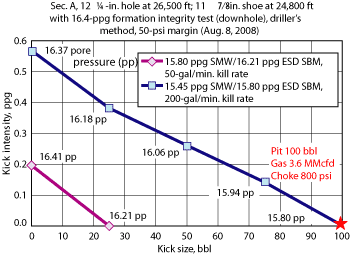 |
|
Fig. 7. Simulation to evaluate kick tolerance limits for different kill rates.
|
|
The choice of appropriate simulation software is, of course, critical. The type of analysis described in this article requires a complete two-phase flow transient model, which includes fluid compressibility, gas solubility, PVT algorithms, momentum, energy, heat transfer, continuity, equations of state, rheology and other effects. Besides real-time support for well control events, these simulations are also useful for well control engineering in designing well plans, and for evaluating kick tolerance limits in any hole section, such as shown in Fig. 7. Since the model includes all occurrences that take place from the pump to the end of the flare line, it is also useful for evaluating a number of other well control aspects of well or rig design, such as the capacity of the mud-gas separator system, or choke-line friction for deepwater subsea BOP operations. 
|
THE AUTHOR
|
 |
Fred Ng is General Manager of Engineering at Wild Well Control, Inc. He has over 25 years of experience in operational, technical and management roles for major and independent operators. Dr. Ng is a mechanical engineer by training, with a BS degree with honors (first class) from the University of New South Wales, Australia, and MS and PhD degrees from Texas A&M University. He has taught courses in mechanical engineering and petroleum engineering at the University of Houston.
|
|
| |
|










